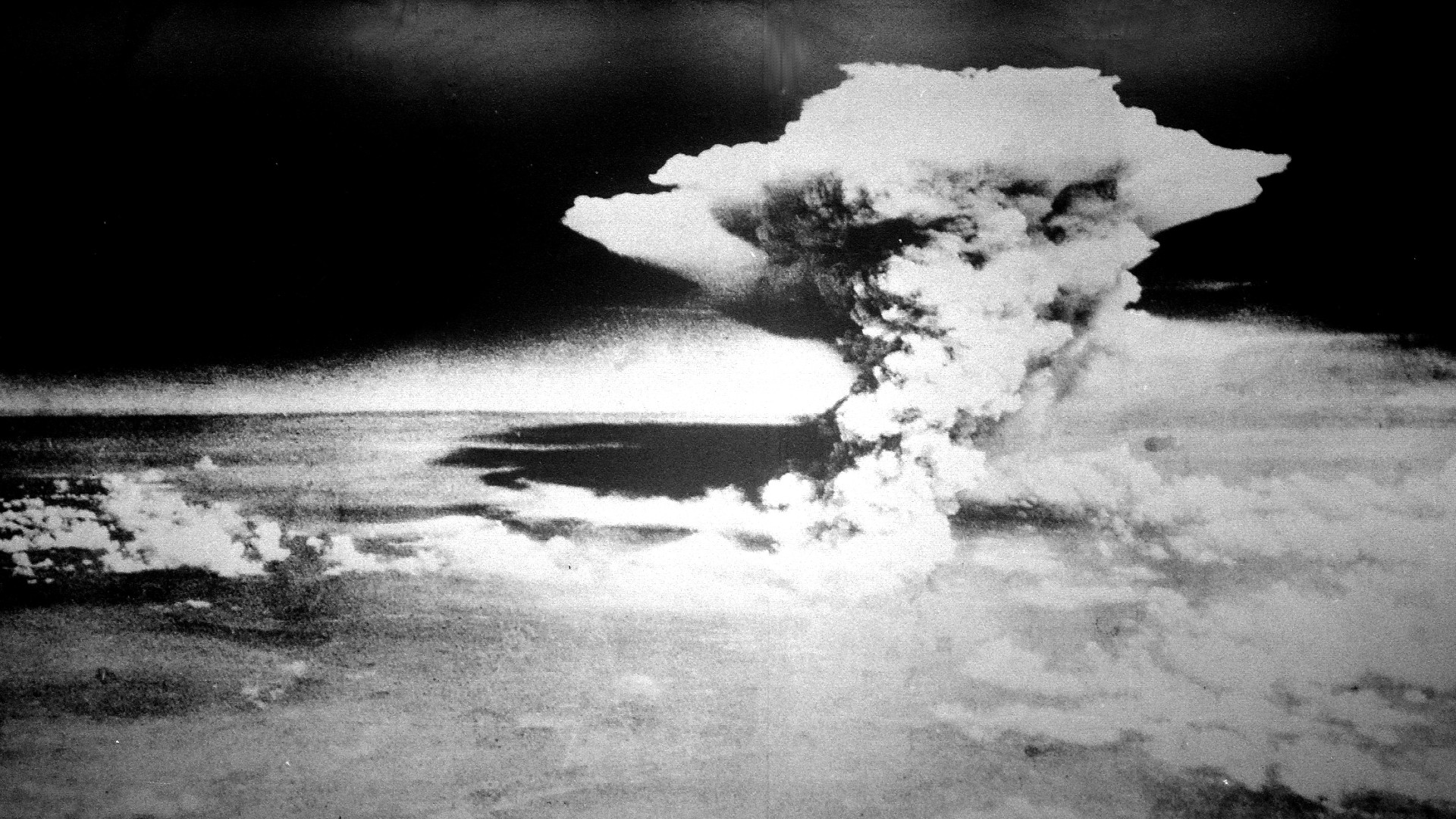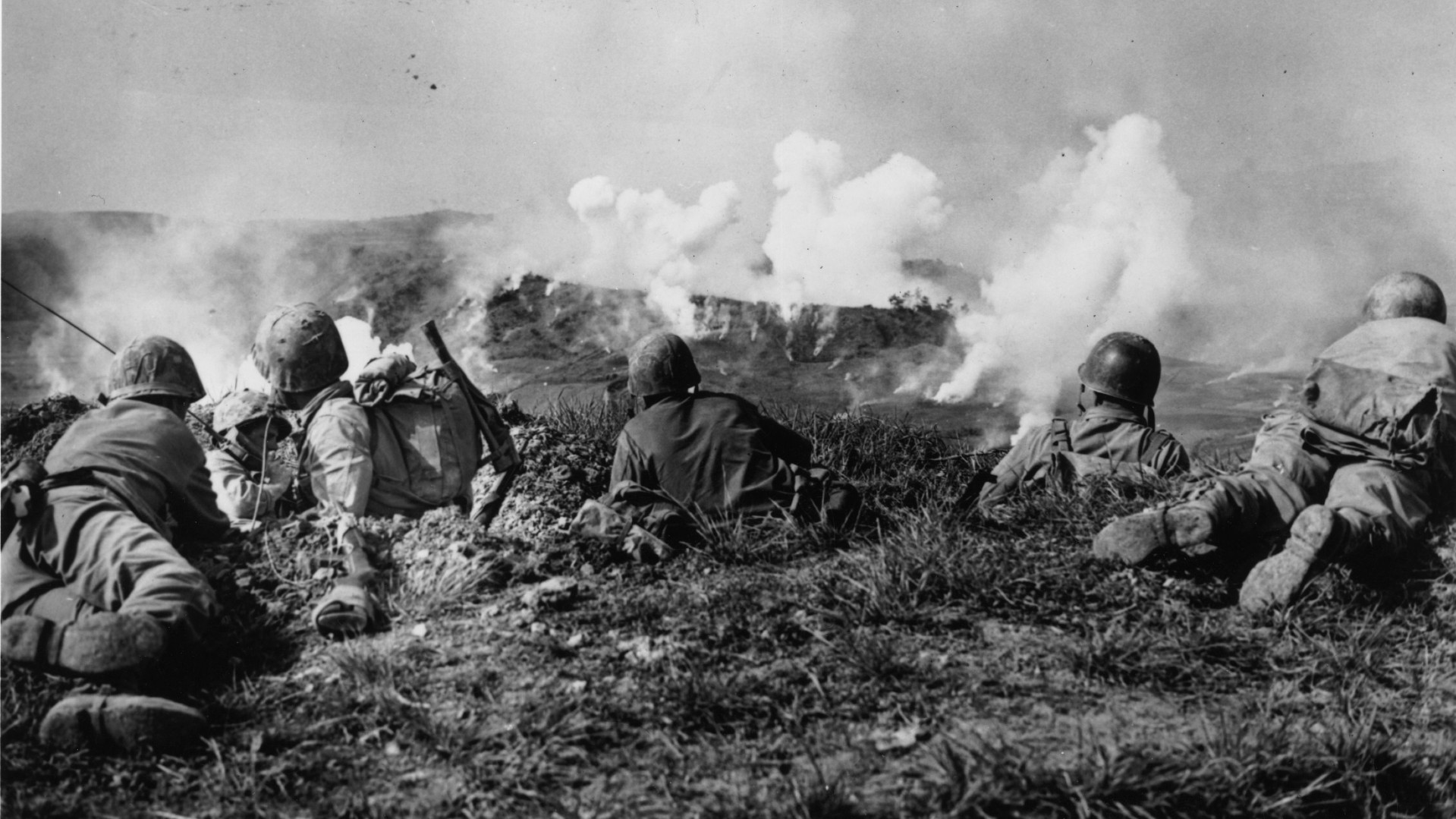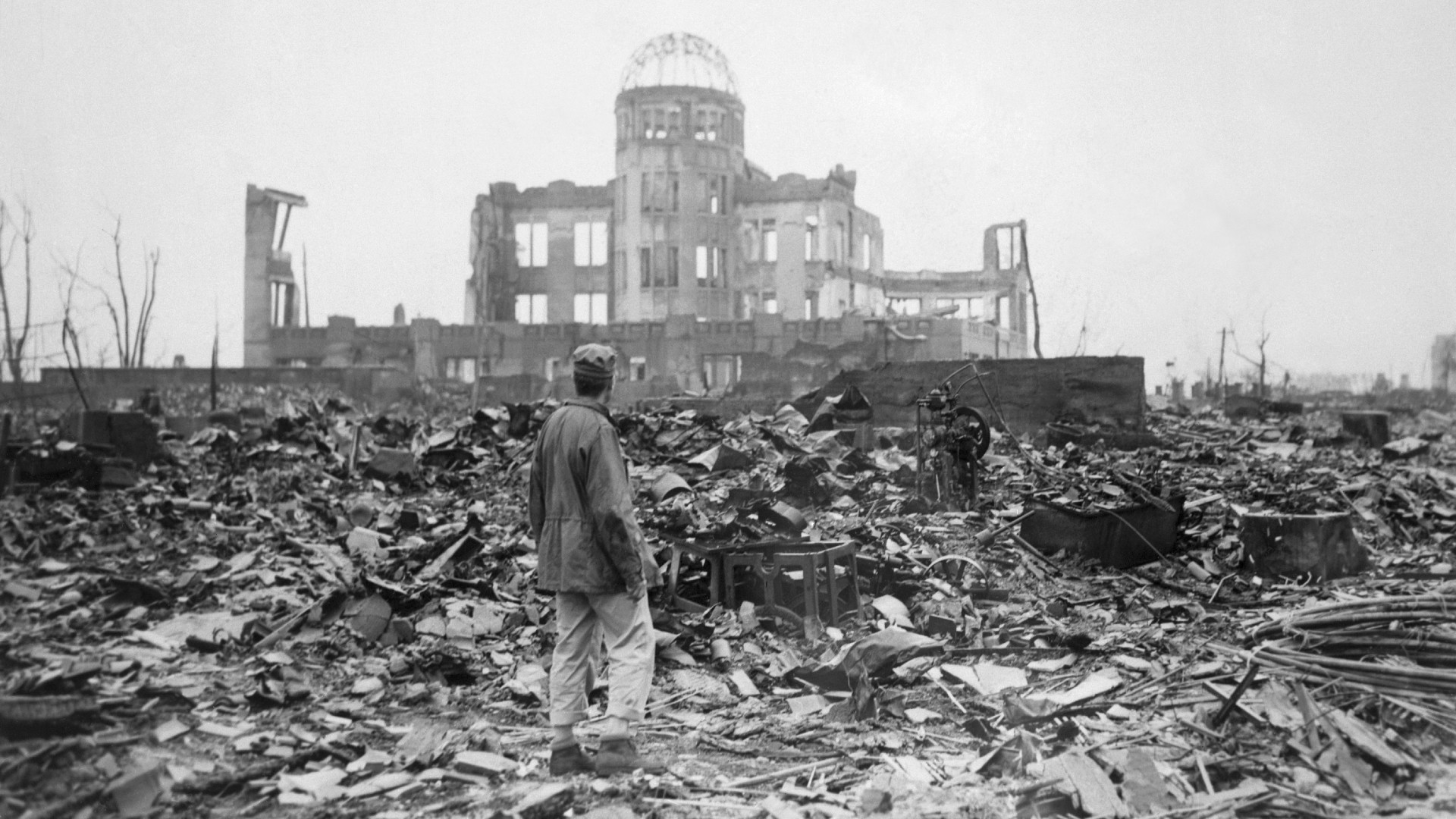The first atomic bombs: Hiroshima and Nagasaki
In August 1945 two atomic bombs were dropped over the Japanese cities of Hiroshima and Nagasaki.

On August 6 and 9, 1945, the United States detonated atomic bombs over Hiroshima and Nagasaki, two small cities in Japan. Still the only use of nuclear weapons against a civilian population, this act changed the way warfare is waged and heralded the dawning of the "nuclear age."
The Second World War
By the summer of 1945, World War II had raged across several continents for six years, beginning when German forces invaded Poland in 1939.
To a world grown weary of death and destruction, the surrender of Nazi Germany on May 8, 1945, was welcome news. Japan, however, vowed to fight to the very end. Their resolve was evident in the battles of Iwo Jima and Okinawa, both of which saw huge U.S. casualties. By June 1945, the U.S. military had lost more than 12,000 soldiers and Japan's military suffered more than 90,000 deaths — plus the loss of an estimated 100,000 Japanese civilians according to the National WW2 Museum.
Against this backdrop, Allied forces drew up plans for Operation Downfall, a large-scale invasion of Japan, according to The Imperial War Museum. But with Allied casualties from an invasion estimated to reach 1 million deaths — plus another 10 million Japanese casualties, including civilians — Allied planners searched for another way to end the war, which they found in the Manhattan Project.
The Manhattan Project
Concerned over reports that Nazi Germany was developing a new type of weapon using radioactive uranium, in 1939 U.S. government officials began to investigate the potential of uranium — particularly the uranium-235 isotope — for making a powerful nuclear bomb, according to the World Nuclear Association.
Within a matter of months, a coalition of American, British and European scientists — many of whom were refugees from Germany, Italy and other fascist nations — began collaborating on a vast international project to develop a uranium-based bomb before any Axis powers beat them to it. One scientist denied clearance to work on the project was Albert Einstein, according to The American Museum of Natural History.
Because one early component of the project was based in the U.S. Army's Manhattan District, the name Manhattan Project eventually stuck,, though work was carried out in Los Alamos, New Mexico; Oak Ridge, Tennessee; Hanford, Washington; Chalk River, Ontario, and several other sites, according to The Bradbury Science Museum.
Get the world’s most fascinating discoveries delivered straight to your inbox.
After several years of intensive research under strict secrecy, the Manhattan Project developed two different bombs that used two different nuclear materials: uranium-235 and plutonium-239, according to the US Department of Energy.
'Little Boy' and 'Fat Man'
About 140 pounds (64 kilograms) of highly enriched uranium-235 was used to create "Little Boy," a nuclear-fission bomb that worked by shooting a large, hollow cylinder of uranium over a smaller uranium insert. Far from little, the bomb weighed about 9,700 pounds (4,400 kg), according to the Bradbury Science Museum.
"Fat Man" was even bigger — about 10,300 pounds (4,670 kg) — and used a core of plutonium-239 to create a nuclear chain reaction that would release the energy of about 21 kilotons of TNT dynamite.
The complexity of the plutonium bomb caused some concern among project engineers, so a test of the bomb was scheduled for July 16, 1945. On that day, at Alamogordo, New Mexico, the first atomic bomb blast the world had ever witnessed occurred, ushering in the Atomic Age.
Hiroshima
In 1945, Hiroshima, Japan, was a city of about 255,000 people that was largely untouched by the war, according to a paper in the American Journal of Epidemiology. Situated on a coastal plain, the city was an important manufacturing and military center — at least 40,000 military personnel were stationed in Hiroshima during the summer of 1945.
For these and other reasons, the city was selected as the first target of an atomic bomb attack. Early in the morning of Aug. 6, a B-29 airplane named Enola Gay (after the mother of its pilot, Colonel Paul Tibbets, according to Time magazine) took off from Tinian, an island roughly six hours from Hiroshima by air. Inside the Enola Gay's bomb bay was "Little Boy."
At 8:15 a.m., the Enola Gay's bay doors opened and "Little Boy" was dropped over Hiroshima. The bomb exploded about 1,900 feet (580 meters) over the unsuspecting city. The enormous blast instantly destroyed most of the city and claimed some 140,000 lives, according to the BBC.
"The mushroom [cloud] itself was a spectacular sight, a bubbling mass of purple-gray smoke and you could see it had a red core in it and everything was burning inside," said the Enola Gay's tail gunner, Staff Sgt. Robert Caron, according to Atomic Heritage. "As we got farther away, we could see the base of the mushroom and below we could see what looked like a few-hundred-foot layer of debris and smoke."
On the ground, however, the scene was more horrific than spectacular. "In the following waves [after the initial blast] people’s bodies were terribly squeezed, then their internal organs ruptured," wrote a journalist with LIFE magazine. "Then the blast blew the broken bodies at 500 to 1,000 miles per hour through the flaming, rubble-filled air. Practically everybody within a radius of 6,500 feet was killed or seriously injured and all buildings crushed or disemboweled."
Nagasaki
To the surprise of some Allied military commanders, the destruction of Hiroshima did not bring about a Japanese surrender. Of the cities remaining on the Allied force's list of potential targets, the ancient fortress city of Kokura was at the top of the list.
Shortly before 4 a.m. on Aug. 9, a B-29 named Bockscar (a pun on the aircraft's captain, Frederick C. Bock according to the Atomic Archive) took off from Tinian, headed for the city of Kokura. In the plane's bomb bay was the plutonium-fueled "Fat Man."
Cloud cover and poor visibility over Kokura spared the city, so the crew of Bockscar headed toward Nagasaki. A large seaport, the city was home to several important manufacturers, including the Mitsubishi Steel and Arms Works, and enterprises devoted to shipbuilding, weapons development and other military industries.
It, too, was obscured by clouds, but the crew was able to find a break in the cloud cover, and shortly after 11 a.m., "Fat Man" exploded over Nagasaki.
The powerful blast destroyed much of the city, and at least 40,000 people were killed immediately, according to the Bulletin of Atomic Scientists. The hilly terrain of Nagasaki — and the fact that the bomb was dropped almost 2 miles (3.2 km) from its intended target — prevented greater destruction.
Nonetheless, by the end of 1945, about 80,000 people died from the bomb over Nagasaki, according to the Columbia K1 Project. About half of the city was reduced to rubble and ash by the blast and the subsequent fires.
Effects of the blasts
At noon on Aug. 15 — six days after Nagasaki was bombed — Japanese Emperor Hirohito announced an unconditional surrender, effectively ending World War II. Jubilant celebrations broke out across the globe, but there was little to celebrate in Japan.
The exact number of deaths from the bombings of Hiroshima and Nagasaki will never be known, but at least 103,000 died from the immediate blast or the effects of radiation sickness, according to the World Nuclear Organization.
There were also a high number of stillbirths and birth deformities reported among survivors of the bombings, according to the Radiation Effects Research Foundation. However, no long-term genetic damage has been reported among the survivor's children, who are subject to ongoing screening.
After the victors' initial celebrations quieted down, there was profound soul-searching by most of the people involved in the decision to use atomic weaponry. The devastation wrought by two just two bombs was unprecedented in human history, and the debate over the use of nuclear weapons remains relevant to this day. Robert Oppenheimer, nicknamed "the father of the atomic bomb" delivered a famous speech in which he qouted the Bhagavad Vita.
"Yesterday man unleashed the atom to destroy man, and another chapter in human history opened, a chapter in which the weird, the strange, the horrible becomes the trite and obvious," wrote a New York Times correspondent one day after the Hiroshima bombing, according to Guy Oakes in "The Imaginary War: Civil Defense and American Cold War Culture" (Oxford University Press, 1995).
Alarmed by the use of atomic weaponry, many of the scientists responsible for the Manhattan Project organized as the Federation of Atomic Scientists, an organization that continues to work against nuclear proliferation.
Originally published on Live Science.
Additional Resources
Learn more about the history of nuclear weapons from The Atomic Foundation. Read more about what occured at Hiroshima and Nagasaki on the Arms Control Associations site.
Bibliography
- National WW2 Museum
- The Imperial War Museum
- World Nuclear Association
- The American Museum of Natural History
- The Bradbury Science Museum
- US Department of Energy
- American Journal of Epidemiology
- Atomic Heritage
- Bulletin of Atomic Scientists.
- Columbia K1 Project
- Radiation Effects Research Foundation
- Guy Oakes in "The Imaginary War: Civil Defense and American Cold War Culture" (Oxford University Press, 1995)

- Callum McKelvieFeatures Editor







